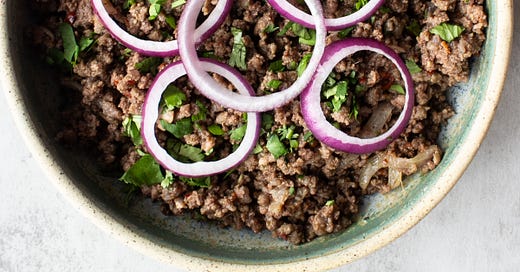Keema Supremacy
Why keema is my favorite Pakistani dish, some Ramadan classics and a bonus recipe for paid subscribers
Pre-order my debut cookbook, Pakistan: Recipes and Stories from Home Kitchens, Restaurants and Roadside Stands. Featuring 100+ delicious recipes, stunning photography and essays that ground the food in place and context, "Pakistan" is the most complete look at Pakistani cuisine to date!
A Filipino friend recently asked what my favorite Pakistani dish was, and I immediately responded keema. A household staple, keema is minced meat prepared in a base of fried onion and spices. On the blog, I recently posted a new recipe for khara masala keema – minced beef with whole spices – that I learned from my friend’s mother, Seema Aunty, in Karachi. It’s a fantastic weeknight dish that comes together in 30 to 35 minutes. The spice blend of freshly ground anar dana (dried pomegranate seeds), dried red chiles, and coriander and cumin seeds, infuse the keema with a tart, smoky and spicy flavor, making it an especially lovely complement to a vegetable side like patta gobi (fried cabbage) or bhindi (okra). This is now, the third keema recipe on the blog; and there’s a fourth completely different in the book.
Keema in All Its Forms
So what’s the secret to switching up your keema game?
Switch Up Your Protein: The first keema recipe I posted on Pakistan Eats was a chicken keema recipe I adapted from my friend, Kulsoom. It’s now one of the most popular recipes on the blog. Like the khara masala keema, it has a more granular texture, and the choice of chicken gives it a lighter feel. This recipe will work for turkey keema as well.
You Don’t Need Tomatoes: The second is an unusual beef keema recipe, which I adapted from the amazing Salt’n Pepper Village Cookbook (why the cookbook is amazing is the subject for another post). It’s unusual because it omits the use of tomatoes. Instead you incorporate a healthy portion of full-fat yogurt, which gives the keema a lovely creamy consistency, and infuses it with a touch of tartness.
In the book, I have adapted a very special recipe for dum keema, which was served in the home of the late Khwaja Murtaza, at religious gatherings every Muharram – a period of mourning for Muslims to commemorate the death of Hussain, the grandson of the Prophet Muhammad - in Islamabad. The keema is marinated in a complex spice blend, garlic and ginger paste, and some meat tenderizer (preferably grated green papaya), before being folded into fried onions. Once done, it is briefly smoked with a lit coal.
Ground Versus Whole Spices: Khara masala refers to ‘whole spices.’ The latest recipe therefore, khara masala keema, insists on the use of whole spices. Well, sort of. In the original recipe, Seema Aunty did use whole spices but in this adapted recipe, I ask you to lightly roast them and coarsely grind them. This is based on the fact that many of my readers prefer not to bite into whole spices. So to strike a balance, I have asked you to opt for freshly and coarsely ground whole spices to retain the intense flavor without the hassle of biting into them.
Keema and…(Insert Blank): In my home, we would normally have keema with potatoes or peas. My friend, Izzah has a lovely recipe for matar keema, and Mehrunnissa Yusuf for keema simla mirch (keema with green bell peppers). I love them both, and make them frequently at home.
South Asians also love keema with pasta! My mother would normally serve it with spaghetti but macaroni is a popular choice too. In case you missed it, I wrote a piece on keema spaghetti for TASTE a few years ago. Check it out. Keema is also folded in aush, a hearty noodle soup, which originated from Afghanistan and Iran, but is also frequently prepared by the Hazara community in Pakistan. The recipe is both in the book, and on the blog.
In case you missed it, now you can upgrade your subscription to support me! Paid subscribers get access to bonus content and subscriber chats. If you decide to become a founding subscriber, you will also get three hours of one-on-one coaching sessions on food publishing (but really any topic of your choosing).
Now, Some Ramadan Content
Ramadan Mubarak to everyone who observes! My friend, Izzah, released a really fabulous and user-friendly meal plan for Ramadan. It’s perfect for busy professionals and parents who want to remove the guest work out of shopping and meal planning. For $12, it’s a steal. Please have a look.
On the blog, some Ramadan classics include:
Sehri
Egg Bhurji or Khagina (Scrambled Eggs with Potatoes): A simple, bright, and filling breakfast of scrambled eggs with potatoes.
Sweet Dalia (Cracked Wheat Porridge): So much better than oatmeal!
Iftar
Chana Chaat with Tamarind Chutney: A classic chaat with chickpeas, tomatoes, and red onions and potatoes, topped with a sweet and sour chutney of tamarind.
Fruit Chaat: A classic fruit chaat of apples bananas and pomegranate seeds with orange juice, sugar and a little bit of chaat masala.
Palak Pakoda (Spinach Fritters): A much lighter version of pakoray, in which I swap out the classic filling of potato and onion with spinach leaves. Kale works well as well!
Other News
Press: Pooja Makhijani covered the release of not one but three cookbooks featuring Pakistani cuisine this year!
Reading
This was published in 2022 but in the spirit of Ramadan, don’t miss Sanam Maher’s great dive into Rooh Afza.
Loved this old Substack post by Apoorva Sripathi of the fantastic newsletter, Shelf Offering, on the joys of a mixer-grinder and the political ergonomics of Indian kitchens.
A great primer on mutton and a delicious recipe for lamb chop masala by the inimitable Noreen Wasti for TASTE.
I recently started Slow Noodles: A Cambodian Memoir of Love, Loss and Family Recipes by Chantha Nguon, and am loving it! I did however, start missing Cambodia all over again.
Social Media
I have begun to share excerpts from the book on Instagram. If you are curious about the book, follow along @maryamxjillani!






Izzah’s matar keema has become my family’s favorite dinner / my 2.5year old’s favorite food! Excited to try all these other keemas!
thanks for the shoutout Maryam, im so glad you liked my essay! i love keema esp with pasta!!